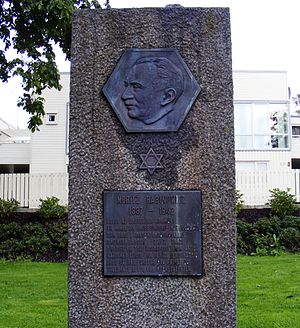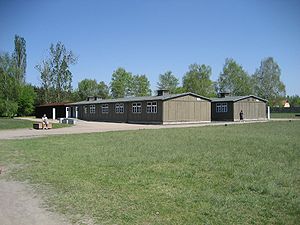- Moritz Rabinowitz
-
Moritz Rabinowitz Born Moritz Moses Rabinowitz
September 20, 1887
Rajgród, PolandDied February 27, 1942 (aged 54)
Sachsenhausen concentration campCause of death Murder by abuse and neglect Resting place Unknown Nationality Norwegian Occupation Industrialist Years active 1909-1942 Employer Self-employed Known for Industrial development, philanthropy, and anti-fascist activism Home town Haugesund, Norway Spouse Johanne Goldberg Children Edith, married Reichwald Parents Isaac Levi
Chaya RosaMoritz Moses Rabinowitz (20 September 1887 – 27 February 1942) was a Norwegian retail merchant based in the city of Haugesund, memorialized for his humanitarian outlook and contribution to his city.
Contents
Family
Rabinowitz was born in Rajgród as a son of Isaac Levi and Chaya Rosa Rabinowitz. It is also known that he had 2 sisters and a younger brother. The brother - Herman Herschel - also immigrated to Norway and settled in Bergen. Rabinowitz wrote that he had witnessed "barbaric" murders during pogroms, particularly in Białystok. As long as he lived, Rabinowitz sent money to his parents in Poland.[1][2]
Rabinowitz married Johanne Goldberg, the daughter of Salomon Goldberg who founded the Friedenstempel in Berlin. They had 1 child, Edith, born in 1918. She married the Austrian refugee Hans Reichwald, and they had a son Harry, born in 1940. Johanne Rabinowitz died on 25 November 1939, after relocating to Bergen to be near her sister Rosa, who had married Moritz's brother Hermann. Rabinowitz traveled extensively along the Norwegian west coast south of Bergen and apparently spent most weekends with his family.[1][2]
By 1942, the widower Moritz Rabinowitz's family in Norway consisted of his daughter Edith, son-in-law Hans, grandson Harry, and sister-in-law Rosa, who was married to his brother Hermann. None of these would survive the Holocaust.[1][2]
Biography
Rabinowitz immigrated to Norway in 1909, at first finding work as a retail clerk in Bergen, then as a peddler. In 1911, he took over the lease of a small cafe in Haugesund and opened an apparel store with only two items in his inventory: one suit and one overcoat. The overcoat was stolen, and he had the suit left for sale. Over time the business grew, and he moved to a larger location in Haugesund and ultimately opened stores also in Odda, Sauda, Stavanger, Egersund, and Kristiansand. He consistently reinvested his profits in growing the business and soon became a mainstay in the apparel retail business in southwestern Norway under the company name M. Rabinowitz. He also started an apparel manufacturing company called Condor. By 1940, Rabinowitz employed about 250 people. He also founded the Hotel Bristol in Haugesund and built what he considered to be one of the best concert halls on the Norwegian west coast along with the Condor manufacturing plant. The Rabinowitz family also had a country home at Førdesfjorden they called Jødeland ("Jewland").[1][2]
Activism
Though he belonged to a small minority in an otherwise homogeneous society with xenophobic tendencies, Rabinowitz became a public figure in Haugesund and surrounding region. He was a frequent contributor of opinion pieces to the local press, addressing issues including labor relations, relief aid to war-torn areas in Spain, Finland, and Austria. He made charitable donations to numerous causes, often anonymously. Among those that are known he gave gifts and financial support for Christmas celebrations in the local jail, orphanage, Blue Cross, and seaman's church. He donated an entire section of Åkrasanden on Karmøy to the citizens of Haugesund for their recreational purposes.[1][2]
He was a lonely voice for several decades against the antisemitism he experienced firsthand in Norway. His nemesis in the op-ed pages was Eivind Saxlund, a leading voice for the antisemitism of the time. His involvement also got national attention from a leading proponent of racist antisemitism, Jon Alfred Mjøen, who brought the issue to the pages of Aftenposten. Rabinowitz also prevailed in a defamation lawsuit against Mikal Sylten, editor of Nationalt Tidsskrift.[3] Taking place in June 1927, it was the second defamation lawsuit against Nationalt Tidsskrift, after the lawsuit from Kristiansund-based chief physician Ephraim Koritzinsky which took place in May.[4]
Rabinowitz expressed his deep opposition to Nazism in the newspaper pages as early as in 1933, figuring that Hitler's "career was only possible in an era as desperate and confused as today's." German Nazi newspapers named him as the Jewish community's secular leader in Norway. In 1934 he wrote that "the new Germany lives in a martial psychosis, specializing in child-rearing for war, and military technique...children are taught from the cradle to hate all foreign peoples and to kill them at the order to do so." In 1934 he also predicted a devastating world war, was unimpressed by the non-aggression treaty between Germany and the Soviet Union. He sent telegrams to world leaders, including Roosevelt, Hindenburg, and Chamberlain, imploring them to intervene on behalf of German Jews. In 1939 he demanded that Norway improve its coastal defense system against a German attack and occupation.[2]
His involvement prompted one reporter to write in Egersundsposten, on 30 January 1940, that: "There may be no other Norwegian who has traveled more extensively in Europe than as Rabinowitz, and he knows the flashpoint Poland inside and out... Rabinowitz is the kind of Jew who shouts from the rooftops that he is a Jew... some may find this irritating... but in truth Rabinowitz is more Norwegian than most of us".[2]
Capture, deportation, and death
Rabinowitz fully expected that the war would come to Norway. On 8 April, the day before the surprise attack came, he submitted his last op-ed article to Haugesunds Avis in which he asked readers to give the Norwegian soldier respect and support. The Germany army landed in Norway on April 9 and Haugesund on April 10. The Gestapo made capturing Rabinowitz its highest priority in the little coastal town. Rabinowitz had prepared several places along the coast as hiding places and moved from one to the other with Gestapo on his tracks. Following the war there was some debate as to why Rabinowitz did not avail himself of four known opportunities to flee the country by sea to England. Among the townspeople of Haugesund, it was rumored that he was too invested in his company and his money. This view, reinforced by stereotypes was rejected in the local papers, when Rabinowitz's (non-Jewish) business manager and several employees emphatically stated that such motivations would be uncharacteristic of him. Subsequent research has shown that he declined passage on two occasions for reasons entirely unrelated to his business affairs[5]
They finally caught up with him in Skånevik, probably by shadowing employees who were conveying business decisions between Rabinowitz and his businesses. By then his daughter, son-in-law, and grandson had joined him.[6]
Rabinowitz was first detained in the regional jail at Lagård in Stavanger, was then sent to Møllergata 19 jail in Oslo on 26 February 1941, and then to Åneby on March 22, until he was sent back to Møllergata on 25 April, where has kept until his deportation on the SS Monte Rosa 22 May 1941.[7] The Monte Rosa landed in Stettin, where he wrote his will. Rabinowitz ended up in Sachsenhausen, where he was placed in the barracks for Jews, though he was officially categorized as a political prisoner. He died on 27 February 1942. The death certificate lists pneumonia as the cause of death, but according to fellow prisoner, Rabinowitz was kicked and stomped to death outside Barrack 38 in Sachsenhausen.[8] [2] Rabinowitz's brother, daughter, grandson, and son-in-law were all later deported and murdered in Auschwitz.[2]
As it happened, Rabinowitz managed to convey his last greetings via a German inmate and another inmate from Haugesund to the people of Haugesund. These were reproduced in the obituary that was published on 20 June 1945. On 6 May 1986, the people of Haugesund erected a memorial stone for Rabinowitz.
Rabinowitz also dictated and signed his last will and testament to a fellow inmate, Carl Mentz Rynning-Tønnesen, where he left all his earthly belongings to his daughter Edith, also expressing a wish that his businesses continue as going concerns. Since Edith and her entire family also were murdered, what was left of Rabinowitz's estate went into probate after the war. After the occupying powers had confiscated his businesses, and at least NOK 300 000 in cash and securities, his estate was valued at NOK 986 000 at the end of the war. The Norwegian government imposed fees and taxes of NOK 450 000 in the course of the next ten years. Among other things, the authorities assumed that Rabinowitz's heirs had died in the sequence that maximized tax liability (and thereby tax revenue) [9].
References
- ^ a b c d e "Å leve eller dø" (in Norwegian) Stiftelsen Hvite Busser http://www.hvitebusser.no/Webdesk/netblast/pages/index.html?id=104841
- ^ a b c d e f g h i Aadnesen, Daniel Magnus (1986) "Moritz Rabinowitz" (in Norwegian) Årbok for Karmsund pp. 57–72 http://www.pergjendem.com/?p=691
- ^ Auestad, Lene (2005). "He was never invited to anyone: "us" and "them" in The Man Who Loved Haugesund". Dictum (3). http://www.dictum.no/pdf/haugesundeng.pdf
- ^ Brattelid, Kristin (2004). Mikal Sylten. Et antisemittisk livsprosjekt. University of Oslo: Institute of Archaeology, Conservation and History. p. 83.
- ^ Haukeland, Jon; Vollan, Tore (2004-02-26). "Hvorfor dro ikke Rabinowitz?" (in Norwegian). Dagbladet. http://www.dagbladet.no/kultur/2004/02/26/391896.html. Retrieved 2008-02-16.
- ^ The entire Reichman family, including Hans's parents Jakob and Jeanette, were arrested in the fall of 1942 and deported to Auschwitz. None of them survived.
- ^ Giertsen, Børre R., ed (1946) (in Norwegian). Norsk fangeleksikon. Grinifangene. Oslo: Cappelen. p. 4.
- ^ "Finn Kleppe" (in Norwegian) Stiftelsen Hvite Busser http://www.hvitebusser.no/Webdesk/netblast/pages/index.html?id=258639
- ^ Våga, Finn; Ola J. Askeland (2010-02-10). "Plyndret etter døden [Plundered after his death]". Stavanger Aftenblad. http://www.aftenbladet.no/lokalt/krigenrogaland/1158734/Plyndret_etter_doeden.html.
External links
- Aadnesen, Daniel Magnus (1986). "Moritz Rabinowitz" ([dead link] – Scholar search). Årbok for Karmsund: 57–72.
- Høines, Daniel M. (2004-01-22). "Mannen som elsket Haugesund" (in Norwegian). http://www.miff.no/nyheter/2004/01/22MannenSomElsketHaugesund.htm. Retrieved 2008-02-16.
- "The Man Who Loved Haugesund". Medieoperatørene. http://mop.no/projects/show/12. Retrieved 2008-02-16.
See also
Categories:- 1887 births
- 1942 deaths
- The Holocaust in Norway
- Polish Jews
- Norwegian Jews
- Polish emigrants to Norway
- Levites
- People from Grajewo County
- People from Haugesund
- Sachsenhausen concentration camp victims
- Norwegian civilians killed in World War II
Wikimedia Foundation. 2010.


